Science & Data Document Library
Science and Data Resources
Interconnection of the Trinity (Glen Rose) and Edwards Aquifers along the Balcones Fault Zone and Related Topics Karst Conservation Initiative

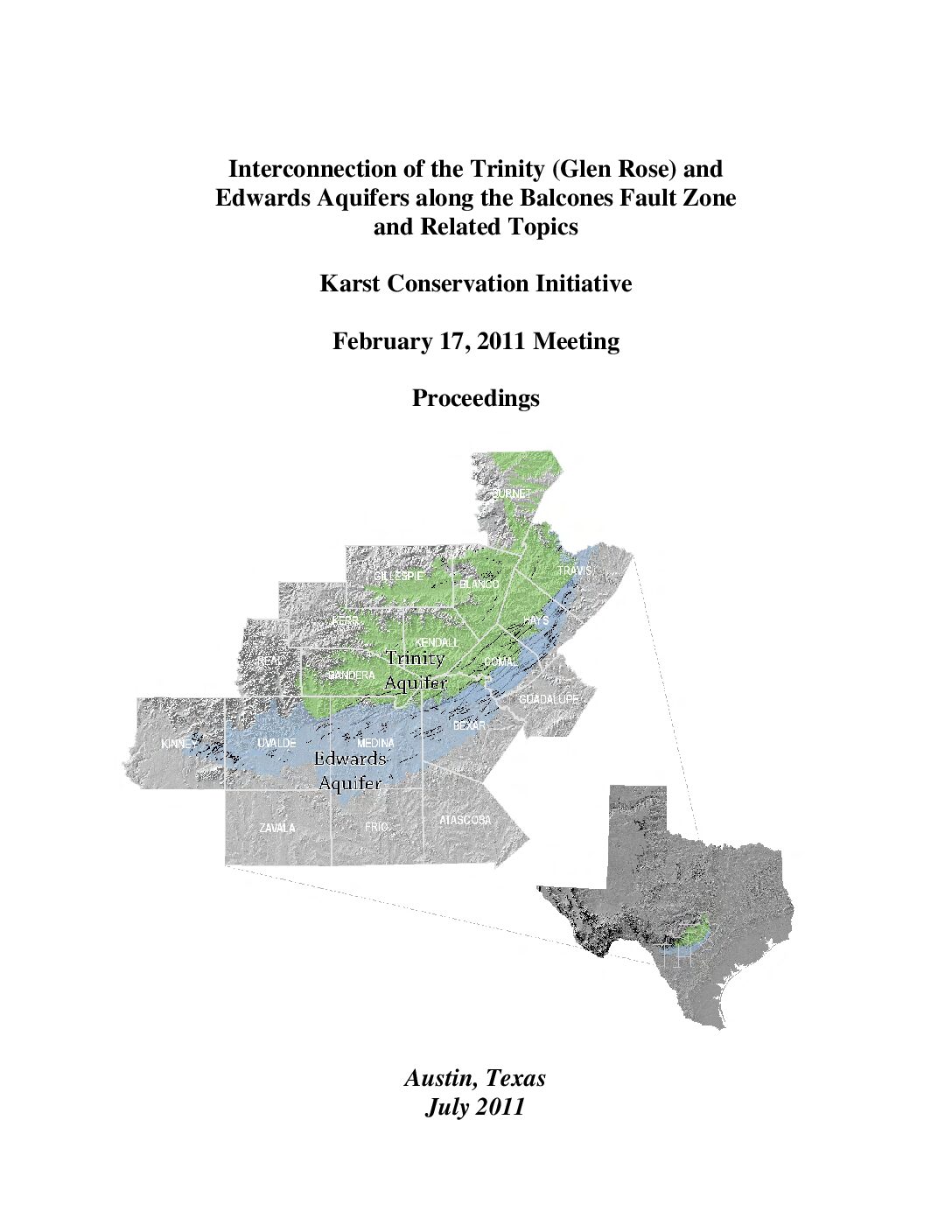
Description: Edwards Aquifer Upper Glen Rose Aquifer Hydraulic Interaction
Report Number: 1131
Location: Edwards Aquifer, Upper Glen Rose Aquifer
Edwards Aquifer Authority Synoptic Water Level Program 2005-2009 Water Level Data

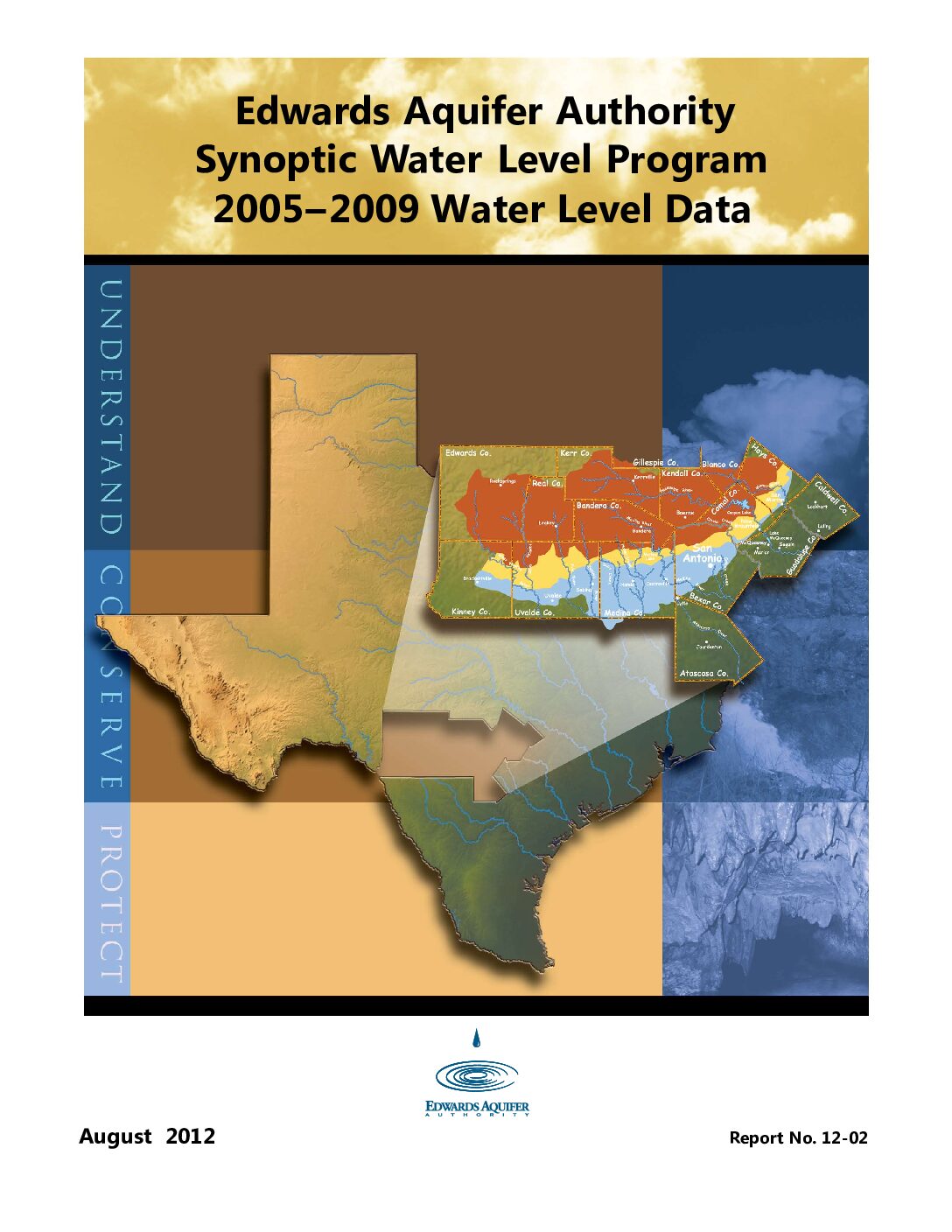
Description: 2005-2009 synoptic water level study
Report Number: 2-Dec
Location: Edwards Aquifer, Balcones Fault Zone, San Antonio Segment
Summary:[Excerpted from Summary and Conclusions]
[T]he study indicates that localized variations exist in the aquifer's flow regime, with the most prominent variations apparently occurring between recharge and artesian zones. The study has also confirmed the need to continue collecting focused synoptic data so that more insight might be gained with regard to flowpaths within the aquifer. Variations detected in the recharge zone of Bexar County confirm the efficacy of additional data points (see Figure 5).
This study has also effectively identified areas in need of more detailed investigation, such as the Knippa Gap, the Cibolo Creek area, and the interface between the Trinity and Edwards aquifers, as well as the recharge- and artesian-zone boundary within the Edwards Aquifer.
Diversion Spring Cave

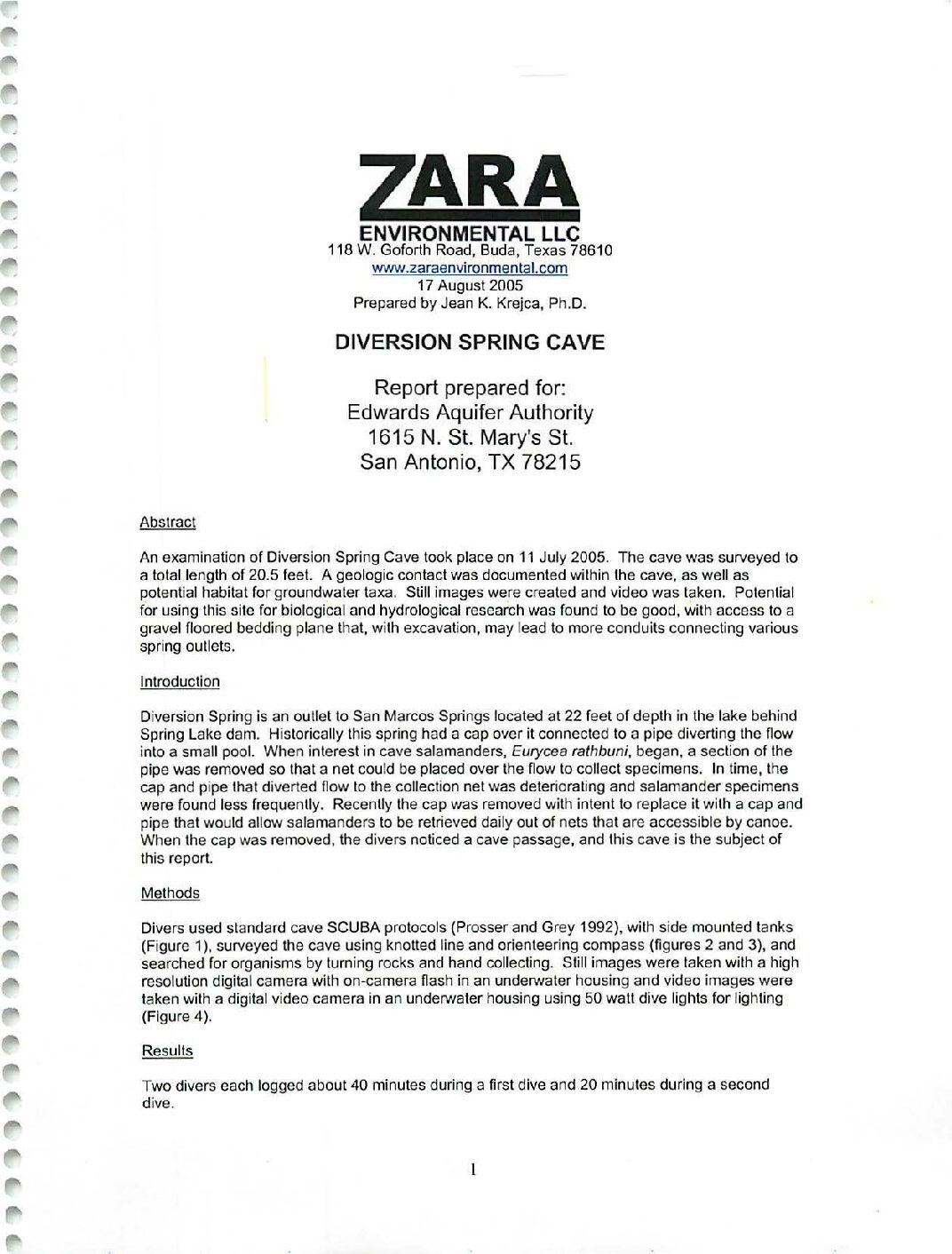
Description: Documentation of hydrogeology, structure and fauna in Diversion Spring Cave, Hays County, TX
Location: Hays County, San Marcos Springs
Summary:An examination of Diversion Spring Cave took place on 11 July 2005. The cave was surveyed to a total length of 20.5 feet. A geologic contact was documented within the cave, as well as potential habitat for groundwater taxa. Still images were created and video was taken. Potential for using this site for biological and hydrological research was found to be good, with access to a gravel floored bedding plane that, with excavation, may lead to more conduits connecting various spring outlets.
A preliminary report of findings for the karst terrains feature known as Rugh Cavern, located along northern Seco Creek, northwestern Medina County, Texas

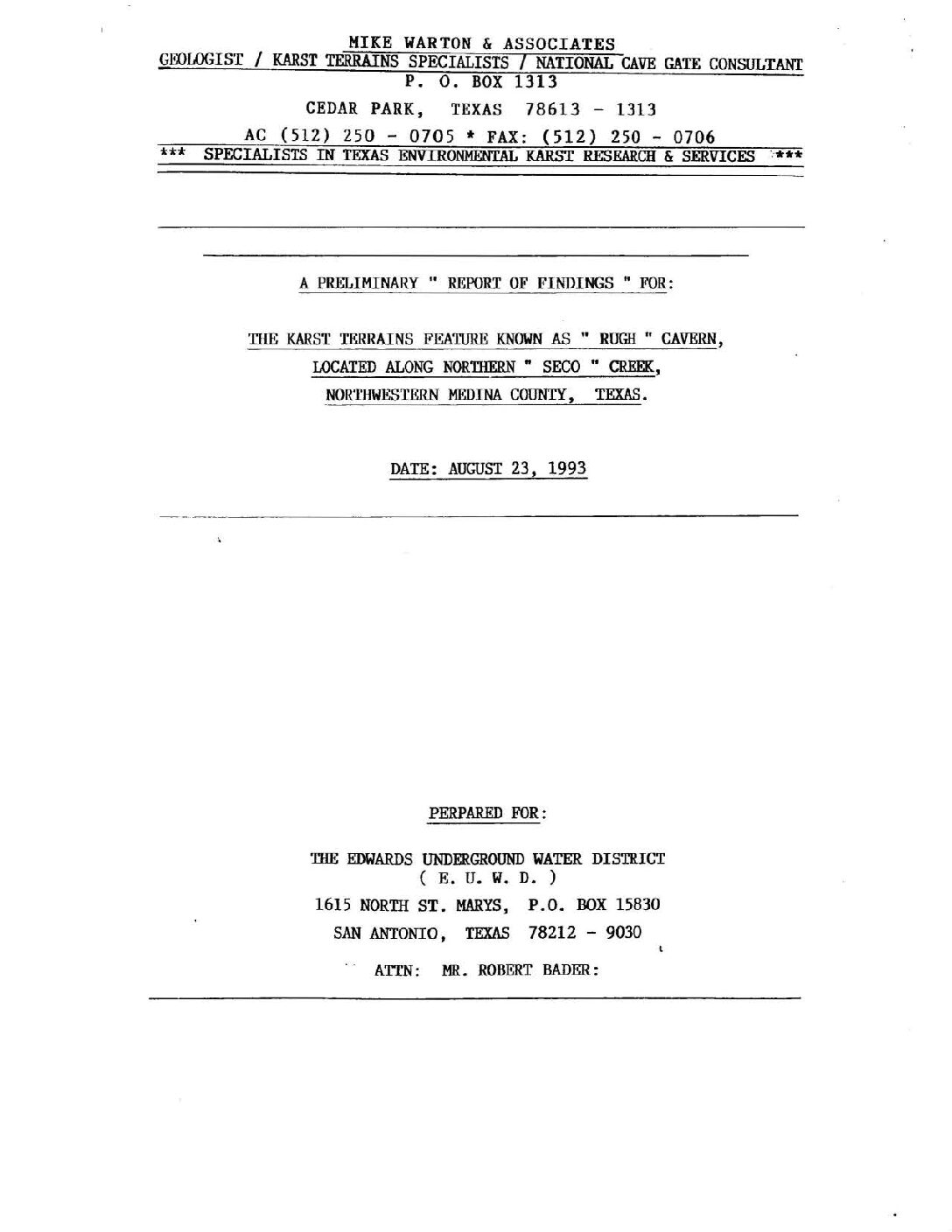
Description: Preliminary findings on Rugh Sinkhole/Cave in Seco Creek, Medina County, TX
Location: Seco Creek, Medina County, TX
Summary:The Karst Terrains Recharge Feature presently known as RUGH SINKHOLE I CAVE is Located approx. 1.5 Miles upstream from the Valdina Farms Sinkhole / Cave Site along SECO Creek in Medina County, Texas. This Feature occurs along the SOUTHWEST Bank of SECO Creek, at which point the Creeks [sic] active wash channel measures 53' Feet wide. The Cave's entrance measures approx. 2.5' Feet wide x 3/5' Feet in Length, and is somewhat Diamond Shaped in configuration. The edges of the entrance consist of a layer of Limestone which is approx. 8 to 10 inches thick, and well undercut below apparently in all directions. The Entrance drop was reported to be an approx. 10' to 12' Foot free drop. At the time I observed this Feature, it was actively insurging approx. 8 to 10 C.F.S., captivating the flow of SECO Creek. The Stream channel flowing into this Feature measured approx. from 6 to 12 inches in depth X 6.0' Feet wide at the Cave's Entrance. It was not possible to enter the Cave under these conditions. Measurements were taken for a protective Recharge Gate. The Cave's Entrance, as well as a large collapse sink further up on the bank are developed along a strong Fracture Lineament Trend of N. 60 E. The distance from the Insurgence Entrance to the collapse sink further up the bank is 59' Feet.
Several observations of this new Recharge Feature were made. This Feature, according to local sources has recently opened up within the last TWO (2) years to a physically accessible size. The Cave's entrance appears to be positioned at approx. 1230' MSL., and developed in the Lower GLEN ROSE LIMESTONE FORMATION (Kgr). It would seem apparent that this subgrade water course is highly likely to connect to the same conduit system represented at the bottom of Valdina Farms Sinkhole / Cave. A dye trace test might be very successful in proving this. This Feature will insurge a great amount of water into the subgrade before the creek flow reaches Valdina Farms Sinkhole / Cave. If any Insurgence figures have been previously calculated for Valdina Farms Sinkhole / Cave, the recharge loss at this new Site would probably significantly effect [sic] calculations at Valdina Farms Sinkhole / Cave. It was my impression, that RUGH Sinkhole / Cave might yield an extensive network of stream conduit passage under exploration efforts.
Some concerns have been expressed for a protective recharge Cave Gate. If & when this would be performed, conditions would have to be dry at the Cave's entrance, which is also an ideal time for exploration efforts and interior documentations. Due to the nature of RUGH Sinkhole / Cave, this Feature represents a very dangerous situation during times of active Insurgence. Gating this Feature most definitely is viewed as a warranted and wise decision.
Preliminary Report of Biological Investigation Valdina Farms Sinkhole-Medina Co., Texas

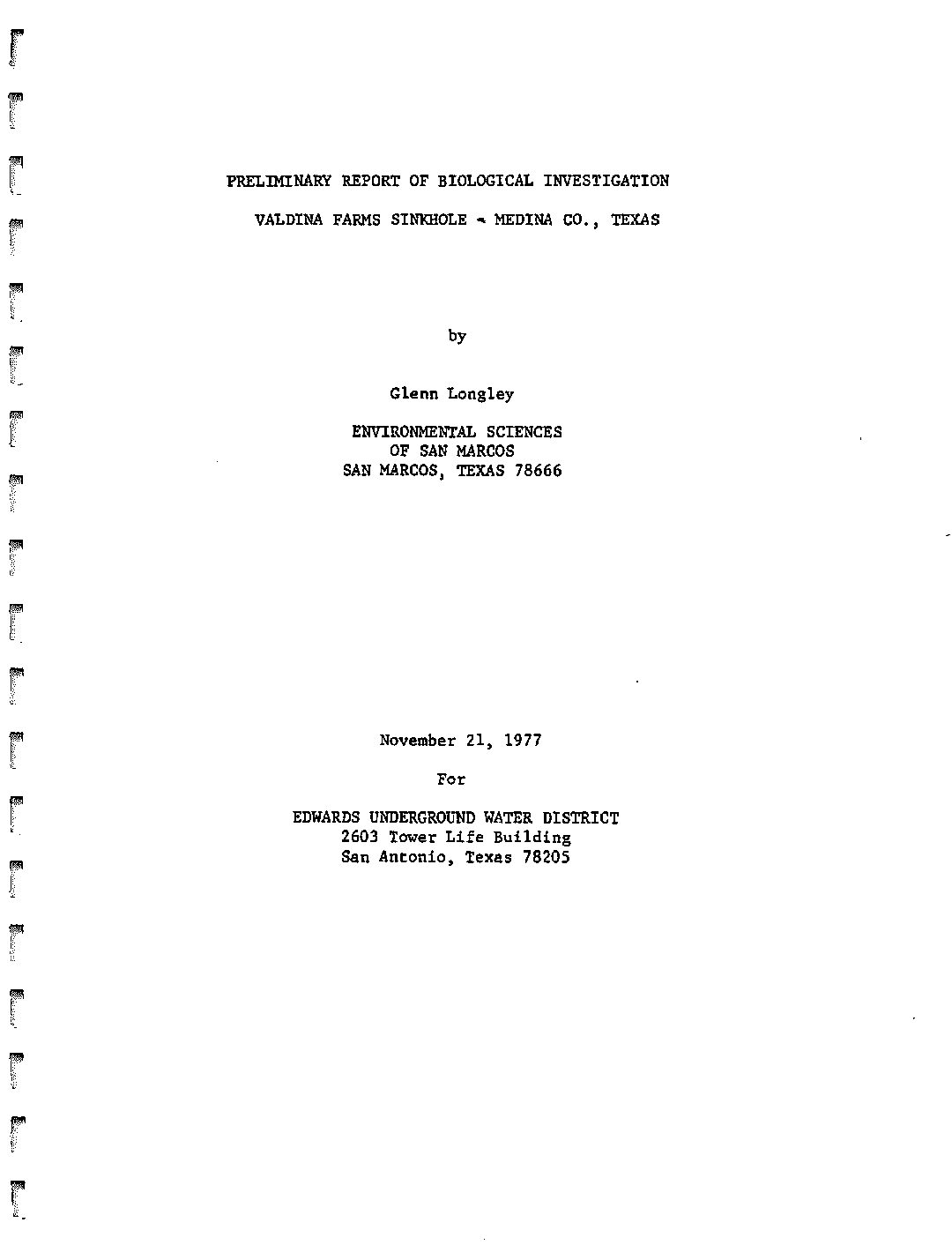
Description: Documentation of fauna in Valdina Farms Sinkhole, Medina County, 1977
Location: Medina County
Summary:Valdina Farms Sinkhole occurs on the recharge zone of the Edwards Aquifer in Northwest Medina County.Geologists of the U.S. Geological Survey have observed large quantities of water entering the sinkhole during floods. The Edwards Underground Water District proposes to construct a dam on Seco Creek with a diversion channel that would direct additional water into Valdina Farms Sinkhole. The U.S. Geological Survey estimates that the proposed construction would add an average of 1400 acre feet of water to the aquifer each year. This flow would otherwise leave the recharge zone. The diversion channel is to be constructed in a manner such that boulders, large rocks and other large debris will not enter the cave.
[Dr. Longley was tasked with surveying the sinkhole and cave, and determining whether or not the proposed dam and diversion channel would adversely affect the fauna living there.]
In summary, the following main conclusions have been derived from this study:
1) The project will not cause the extinction of Eurycea troglodytes (Valdina Farms Salamander).
2) There is considerable doubt that the salamander is a distinct species, but instead is a form of Eurycea neotenes (Edwards Plateau Spring Salamander) ¢
3) The cave will not plug up as a result of the proposed project.
4) The additional recharge that will include some non-toxic organic matter will stimulate the subterranean ecosystem.
5) The recharge will be of considerable benefit to the aquifer which is having ever increasing demands placed on it by pumping.
6) This will likely benefit organisms in springs fed by the aquifer due to prolonged flow.
7) This site is one of the best possible choices for additional recharge due to the low population density in the watershed above the site. Due to its location this area will not be heavily populated in the foreseeable future.
8) Any risk to terrestrial forms in the cave is far outweighed by the benefits to organisms in other areas (this includes man).
9) Pesticide use in the area above the watershed should be maintained at present levels which apparently are minimal.
10) Persons involved in the evaluation of this project should look at the overall benefits and weigh them against the potential costs environmentally.
South Texas Weather Modification Association Edwards Aquifer Authority Target Area 2009 Report

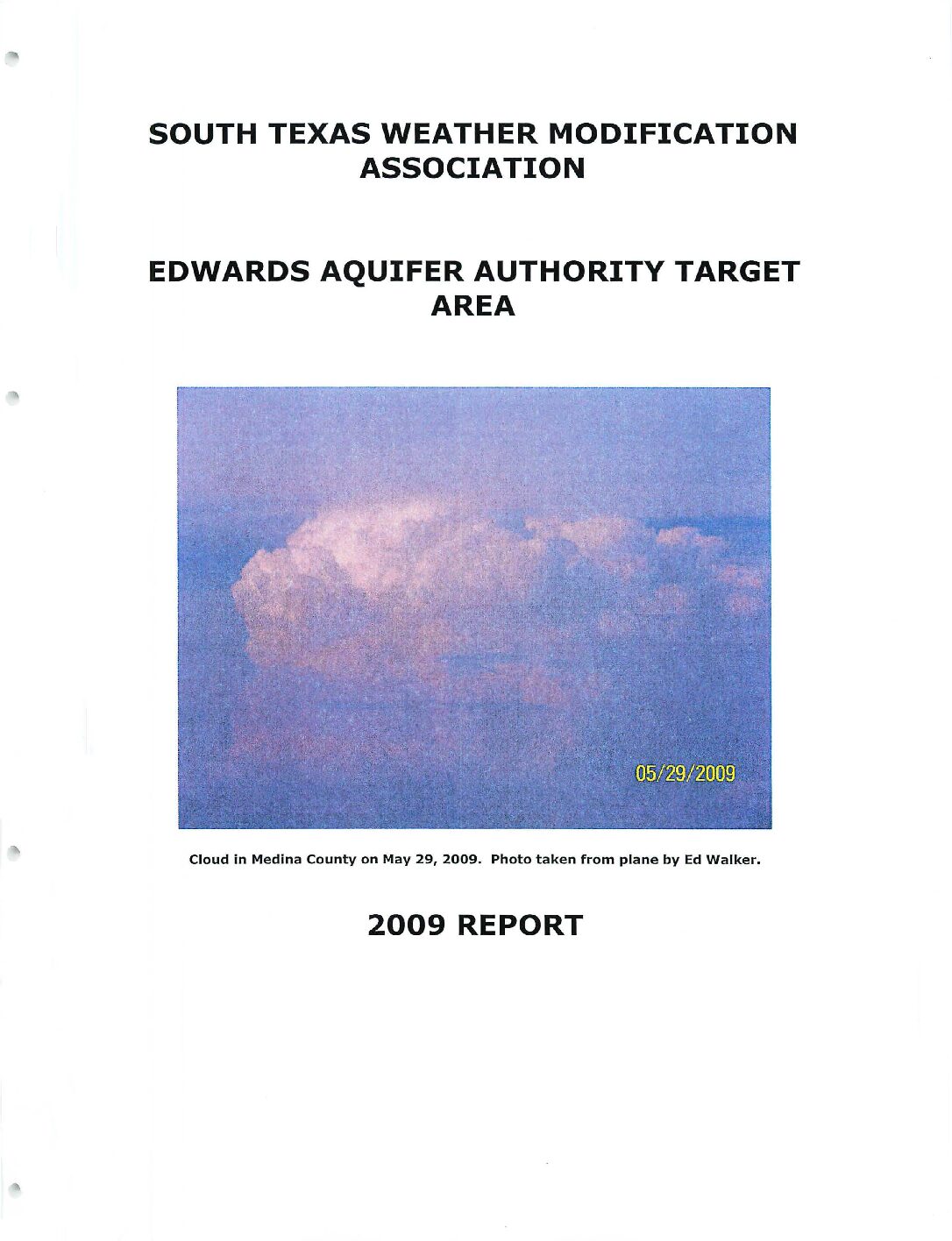
Description: Weather modification program by South Texas Weather Modification Association for the Edwards Aquifer Authority in 2009
Location: South Texas
Summary:The 2009 season marked year number eight for cloud seeding operations for the STWMA in the EAA's trl-county area of Bandera, Bexar and Medina. The latter half of May saw several disturbances affecting the area, bringing a number of seeding opportunities to the target area including one randomized seeding case.Toward the end of [June] a couple more days of favorable weather al lowed for seeding operations.By the end of [August}, San Antonio had recorded its warmest June to August period since record keeping began.
Tropical moisture, which had been largely absent for much of the summer, also began to affect the area with showers and thunderstorms dropping heavier amounts of rain than had been seen all summe [in September]. While this was certainly good news for the area, in terms of cloud seedability the highly tropical air mass produced many unfavorable clouds for treatment. There was one more randomized case on the 1st.
With the conclusion of the season, radar data from the TITAN machine were sent to Archie Ruiz, who works for Active Influence performing radar evaluations for the Texas weather modification projects. Despite the dry weather experienced much of the season, the analysis does indicate increases in rainfall from the clouds that were able to be seeded.
The STWMA continued with an experiment within the EAA target area where randomized seeding would take place.Radar data from each day was also to be saved, again for future analysis.
2009 saw only two randomized seeding cases coming to fruition. The continuing problem of clouds developing in clusters as opposed to being isolated resulted in many no-case days.
Assessment of Recharge Benefit from Enhanced Rainfall

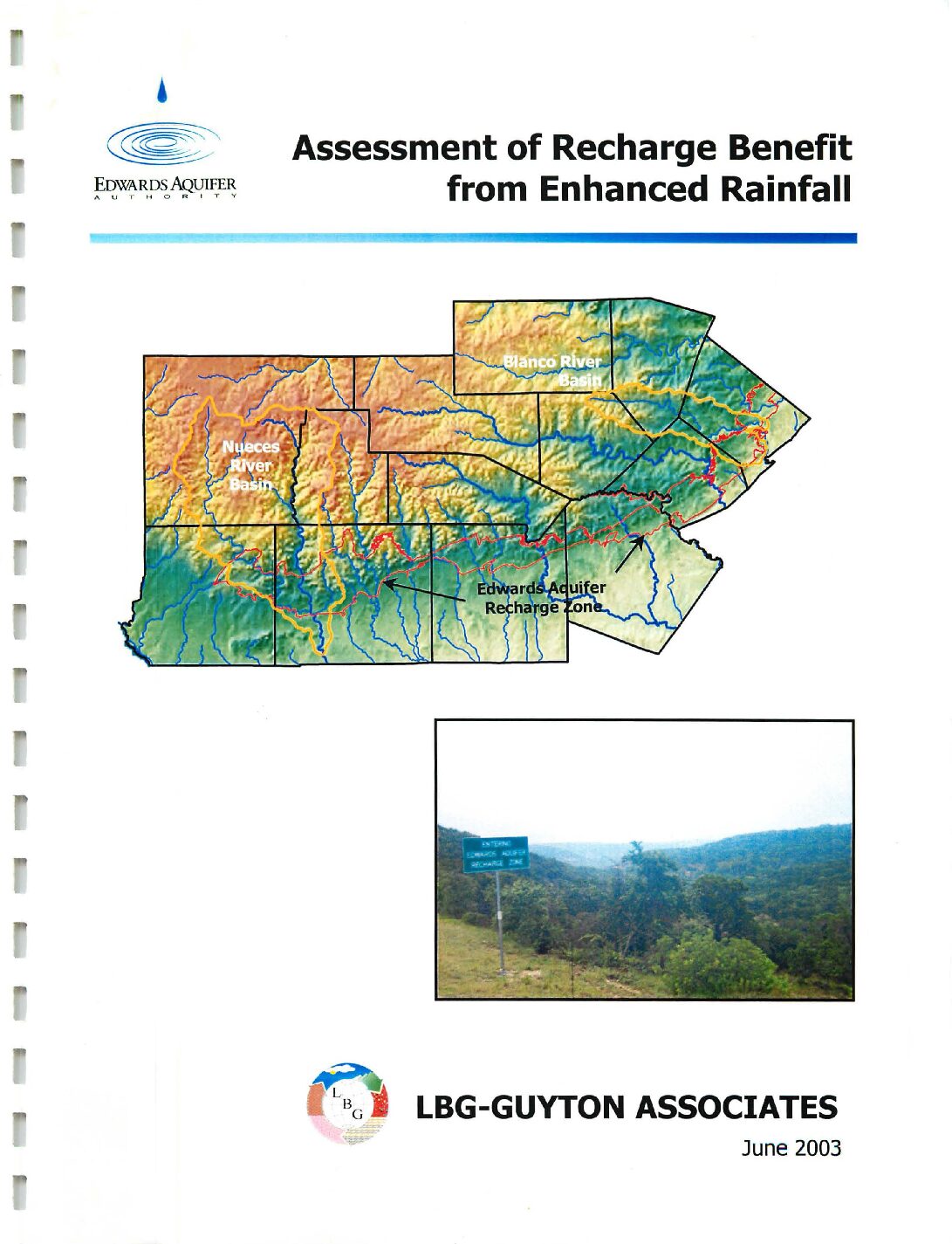
Description: Using the HSPF model to estimate recharge in the Blanco and Nueces River basins from the Edwards Aquifer Authority Precipitation Enhancement Program in 1999-2001
Location: Blanco River Basin, Nueces River Basin
Summary:LBG-Guyton Associates has used pilot recharge models (developed using HSPF (Hydrologic Simulation Package Fortran)) for the Nueces and Blanco River basins to estimate the total amount of increased recharge to the Edwards aquifer during the 1999, 2000, and 2001 Precipitation Enhancement Program (PEP) seasons. Woodley Weather Consultants (WWC)(2002) provided estimates of rainfall and seeding-induced rainfall increments for the Nueces and Blanco basins during the 1999, 2000, and 2001 seasons. These estimates of increased precipitation were used as a basis for simulating the impact of the PEP on aquifer recharge.
Modeling results indicate the total increased aquifer recharge during 1999, 2000, and 2001 in the Nueces basin was 663, 655 and 654 acre-feet per year respectively, which represents a 0.45, 0.34 and 0.19 percent per year increase respectively. The total increased recharge during the three-year period was 1,972 acre-feet, or 0.29 percent in the Nueces basin. In the Blanco basin, the increased aquifer recharge was 152, 179, and I ,00 I acre- feet per year respectively, which represents a 0.44, 0.56, and 1.92 percent per year increase respectively for the Blanco basin. The total increased aquifer recharge during the three-year period was I ,332 acre-feet, or 1.13 percent in the Blanco basin. About half of the Nueces basin is in the c loud seeding zone, which may have reduced the impact of the PEP with regard to aquifer recharge in that basin.
WWC (2002) indicates that the enhanced precipitation during the 1999, 2000, and 2001 seasons could have been increased if more cloud seeding had been performed. To simulate the effect of potentially greater enhanced precipitation, Scenario I was simulated. Scenario I assumed that the enhanced precipitation was equal to one inch on each of the days for which cloud seeding was considered successful (i.e., five days for Nueces basin and eight days for Blanco basin during the 3-year period). Scenario I modeling results indicate that the total increased aquifer recharge during 1999, 2000, and 2001 in the Nueces basin was 4, 123, 754, and 2,029 acre-feet per year respectively, which represents a 2.8, 0.4, and 0.6 percent per year increase respectively in the total recharge for the Nueces basin. The total increased recharge during the three-year period was 6,906 acre-feet, or 1.0 percent in the Nueces basin. In the Blanco basin, the increased aquifer recharge was I ,717, 550, 2,828 acre-feet per year respectively, which represents a 5.0, 1.7, 5.5 percent per year increase respectively in the total recharge for the Blanco basin. The total increased aquifer recharge during the three-year period was 5,095 acre-feet, or 4.2 percent in the Blanco basin.
Limitations and assumptions of the modeling methodology are discussed in this report. Important factors affecting the evaluation of the PEP are the spatial and temporal accuracy of the precipitation data and the inability of the pilot models to simulate hydrology in the contributing zones of the watersheds that recharge the aquifer. In order to evaluate the PEP in the future, it is recommended that appropriate resources be applied to collecting and evaluating precipitation data, especially during the PEP season. In addition, future models should simulate the hydrology of the entire watershed instead of j ust the recharge zone.
Edwards Aquifer Precipitation Enhancement Program Final Report 2001

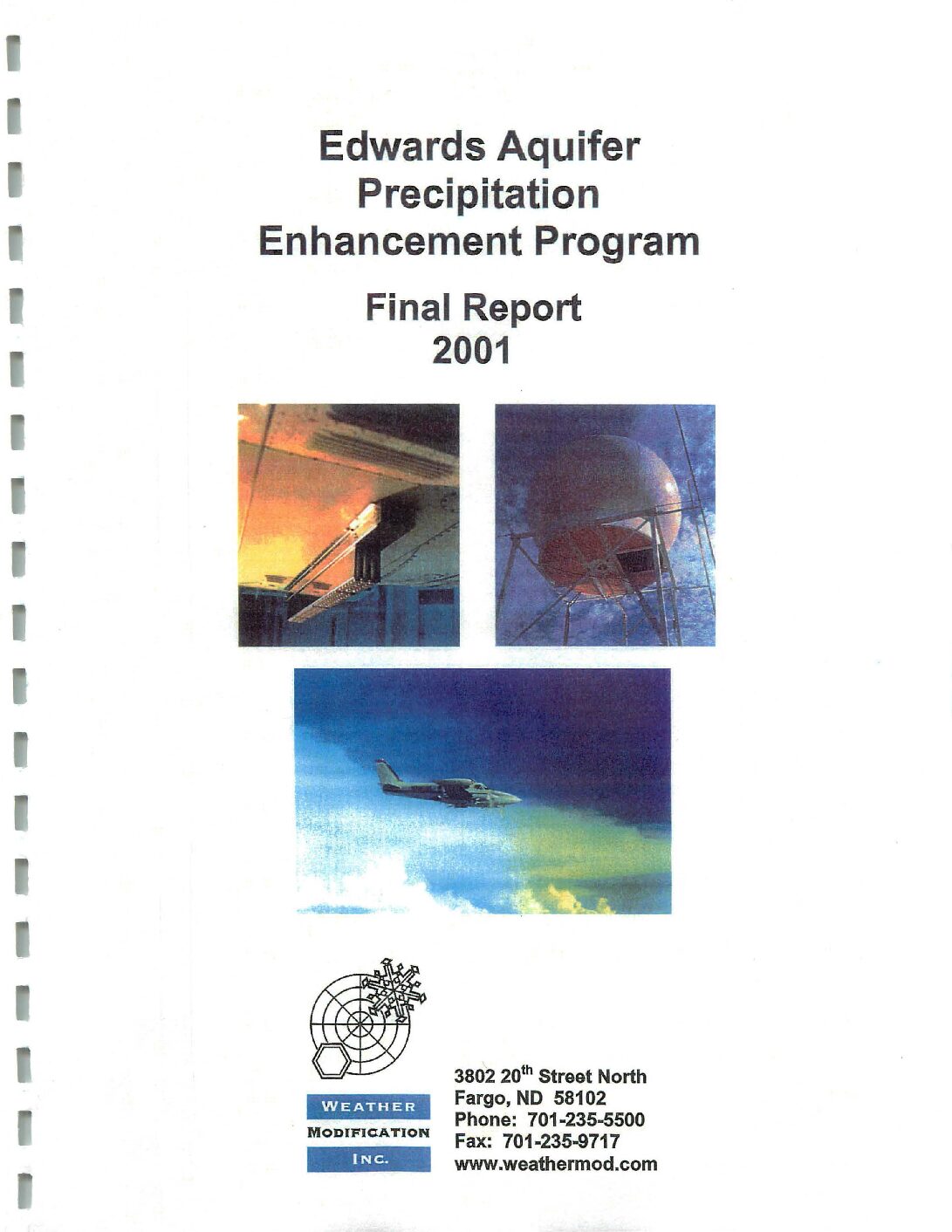
Description: Summary of the Edwards Aquifer Precipitation Enhancement Program for 2001
Location: South Central Texas
Summary:This report summarizes the activities and data collected during the 2001 field operations of the Edwards Aquifer Precipitation Enhancement Program. This was the third year of a program conducted by Weather Modification Inc. (WMI) of Fargo, North Dakota, for the Edwards Aquifer Authority (the Authority) of San Antonio, Texas. The program was funded by the Edwards Aquifer Authority, the Texas Natural Resources Conservation Commission, and the Texas Department of Agriculture, with the sole intent being enhancement of precipitation through cloud seeding. The project area covered 6.37 million acres across south Texas, including all or parts of the following 12 counties: Bandera, Bexar, Blanco, Caldwell, Comal, Guadalupe, Hays, Kendall, Kerr, Medina, Real, and Uvalde. Seeding operations were conducted 24 hours-a-day, seven days a week from April 15 through September 15.
The facilities and procedures for this project were as follows: One C-band weather radar, computers, and a communications system were set up at the centrally located Hondo Regional Airport in Hondo, Texas, to monitor storms and control aircraft. The radar operated continuously throughout the five-month period. The storms, as detected by radar, were posted on the WMI Internet Home Page at 15-minute intervals, thus allowing remote near real-time viewing of operations. Two specially equipped cloud seeding aircraft were dedicated to the project; both were stationed in Hondo. On August 13, 2001, a hangar containing one of the aircraft caught fire and was destroyed, along with the aircraft. A replacement aircraft arrived at Hondo on August 14. Both aircraft were relocated to the Castroville Airport, 15 miles east of Hondo, on the morning of August 14.
High yield formulations of silver-iodide pyrotechnics and acetone solutions were used to generate high concentrations of very fast acting ice-nuclei. High performance aircraft crewed by experienced pilots and directed by experienced radar meteorologists treated developing regions of the storms by direct injection with the seeding agents.
The 2001 field program successfully achieved its objective, to seed those cells thought to have the potential to produce precipitation. During the five-month project, the two aircraft safely completed 58 flights totaling 152 hours 58 minutes. A total of 21.7 kg of seeding agent was dispensed in the form of 834 ejectable flares and approximately 82.8 gallons of silver iodide acetone solution, which was burned in wing-tip generators.
This final report for 2001 provides a general overview of the program and describes the methodology used. Pictures, tables, graphs, and references are used to summarize the operational activities. All of the project's radar data, meteorological data, and reports (weekly operations summaries and monthly reports) have been recorded onto CD-ROM and are available to the Authority.
South Texas Weather Modification Association Edwards Aquifer Authority Target Area 2008 Report


Description: Weather modification program by South Texas Weather Modification Association for the Edwards Aquifer Authority in 2008
Location: South Texas
Summary:2008 marked year number seven in terms of cloud seeding operations for the STWMA in the EAA's tri-county area of Bandera, Bexar and Medina. Cloud seeding operations took place on fourteen days during the season.
At the request of the EAA, the STWMA continued with year two of a three-year experiment within the EAA target area where randomized seeding would take place.Within the tri-county area of Bandera, Bexar and Medina, there were no candidates that presented themselves for randomization. Only one cloud in the 5 month season, in Uvalde County, satisfied the criteria for protocol enactment.
South Texas Weather Modification Association Edwards Aquifer Authority Target Area 2007 Report

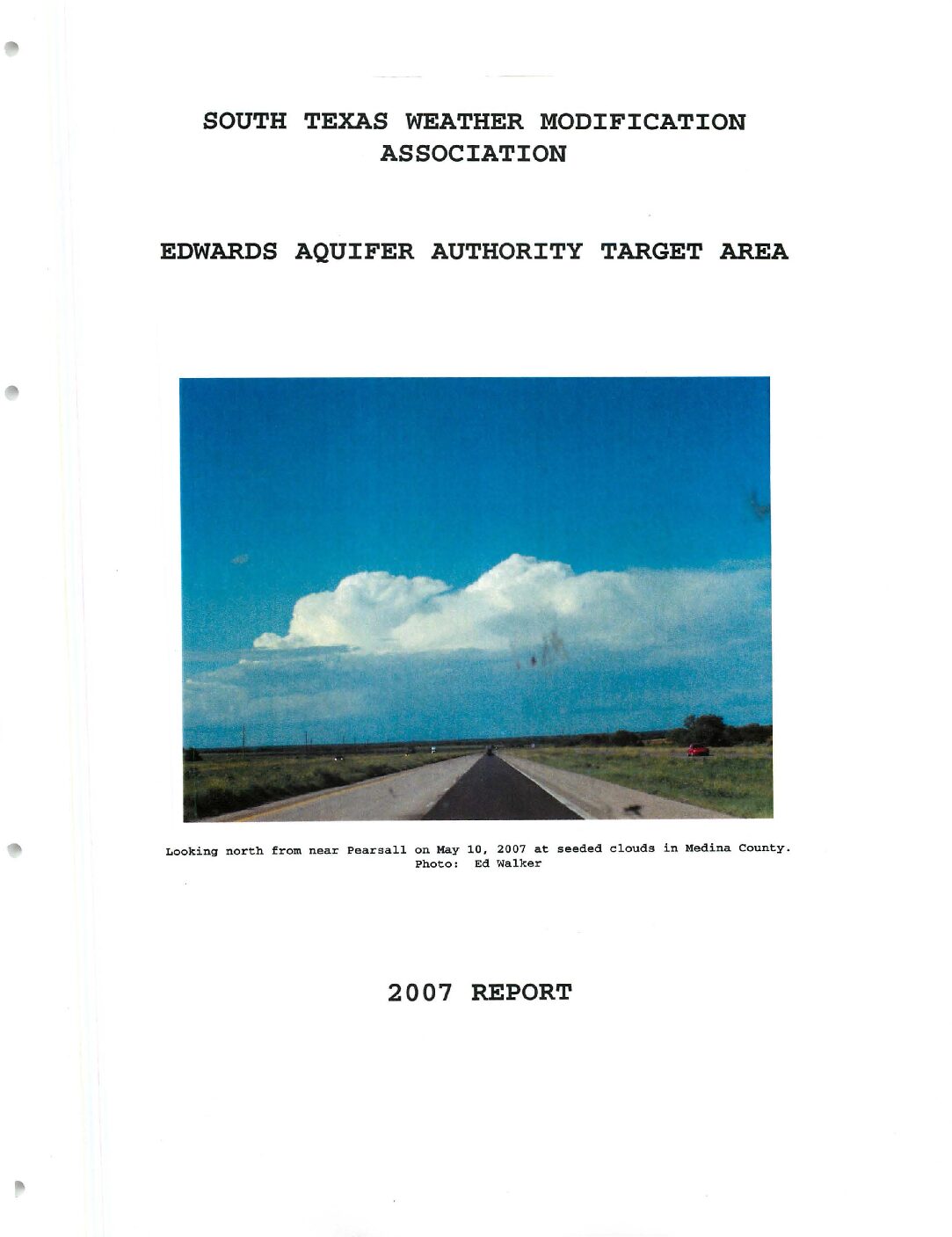
Description: Report of the Edwards Aquifer Authority weather modification program for 2007
Location: South Texas
Summary:STWMA continued to conduct cloud seeding operations over the tri-county EAA target area in 2007, marking year number six. The past year was rather wet, with several intense rainfall episodes occurring in south-central Texas primarily in the May through August period. On several occasions event totals topped ten inches. Because of the persistent heavy rains and subsequent flooding, seeding operations were conducted on fewer days than in years past. 2007 was comparable to 2002, the last time destructive flooding occurred within the target area.
Operations took place on eleven days, with cloud seeding occurring on eight of these days. This compares with 14 days of seeding in 2006, 25 days of seeding in 2005, 20 days of seeding in 2004, 22 days in 2003, and 8 days in 2002.
One of, if not the best day for cloud seeding this past year was on May 10 (photo on cover) when an upper low over north-central Texas helped ignite showers and thunderstorms across the target area. Aggressive seeding of developing showers and thunderstorms took place, with several cells merging into a line that traversed the central and southern EAA target area and continued all the way to Corpus Christi by late that evening. Another day of seeding took place on the 24th. It would be nearly two months before another day of seeding would occur; a reconnaissance flight took place on July 14th but convection would die before the plane arrived. Between June and mid-August, over 20 inches of rain fell over a good portion of south-central Texas. Suspensions took their toll on seeding, with over six weeks of down time. It was a bittersweet result: Although we did not seed as many clouds as years past, the drought had come to a temporary end. Seeding operations resumed in mid-August, with the bulk of the seeding missions for 2007 taking place between August 15th and September 1st. A recon flight on September 27th would be the final flight for the EAA target area for the year.
The annual evaluation conducted by Archie Ruiz at Active Influence is not available for this report.
At the request of the EAA, the STWMA began a three-year experiment within the EAA target area where randomized seeding would take place. With a bit of guidance from the National Center for Atmospheric Research (NCAR), a randomization protocol was developed that would guide both the pilot and the meteorologist in conducting a randomized seeding experiment. The flight to the area of developing convection would take place and the pilot would determine if the activity was seedable based on cloud appearance, inflow strength and location. Once a seedable candidate was found, the randomized decision procedure would take place. This involves both the meteorologist and pilot opening an envelope, inside of which would be a card with either SEED or NO SEED written on it. The meteorologist would convey his envelope content to the pilot, but the pilot would not tell the meteorologist what was in his envelope. If both envelopes matched, the pilot would seed the cloud. He would continue the mission as usual, burning flares as long as conditions warranted. If the envelopes did not match, the pilot would continue to fly in the favorable location, but only pretending to burn flares as long as conditions warranted. By doing the randomization in this manner, only the pilot truly knows if the cloud or clouds were seeded. The cards and notes for each day were to be placed into separate manila envelopes for future analysis, the purveyor of which has yet to be determined. Radar data from each day was also to be saved, again for future analysis. There were a few exceptions to the randomization enactment. If the activity was on the edge of the target area about to exit, if the clouds were too small, or if warnings were issued, the randomized protocol was not put into effect.
As it turns out, 2007 was not the best year for starting this experiment. The weather was not very cooperative, with only five of the eight days allowing for the randomized protocol to be enacted. In addition, it was not until late June before the protocol was developed.
It is the hope of the STWMA that the upcoming seasons will be more favorable for continuing the randomized experiment.
South Texas Weather Modification Association Edwards Aquifer Authority Target Area 2006 Report

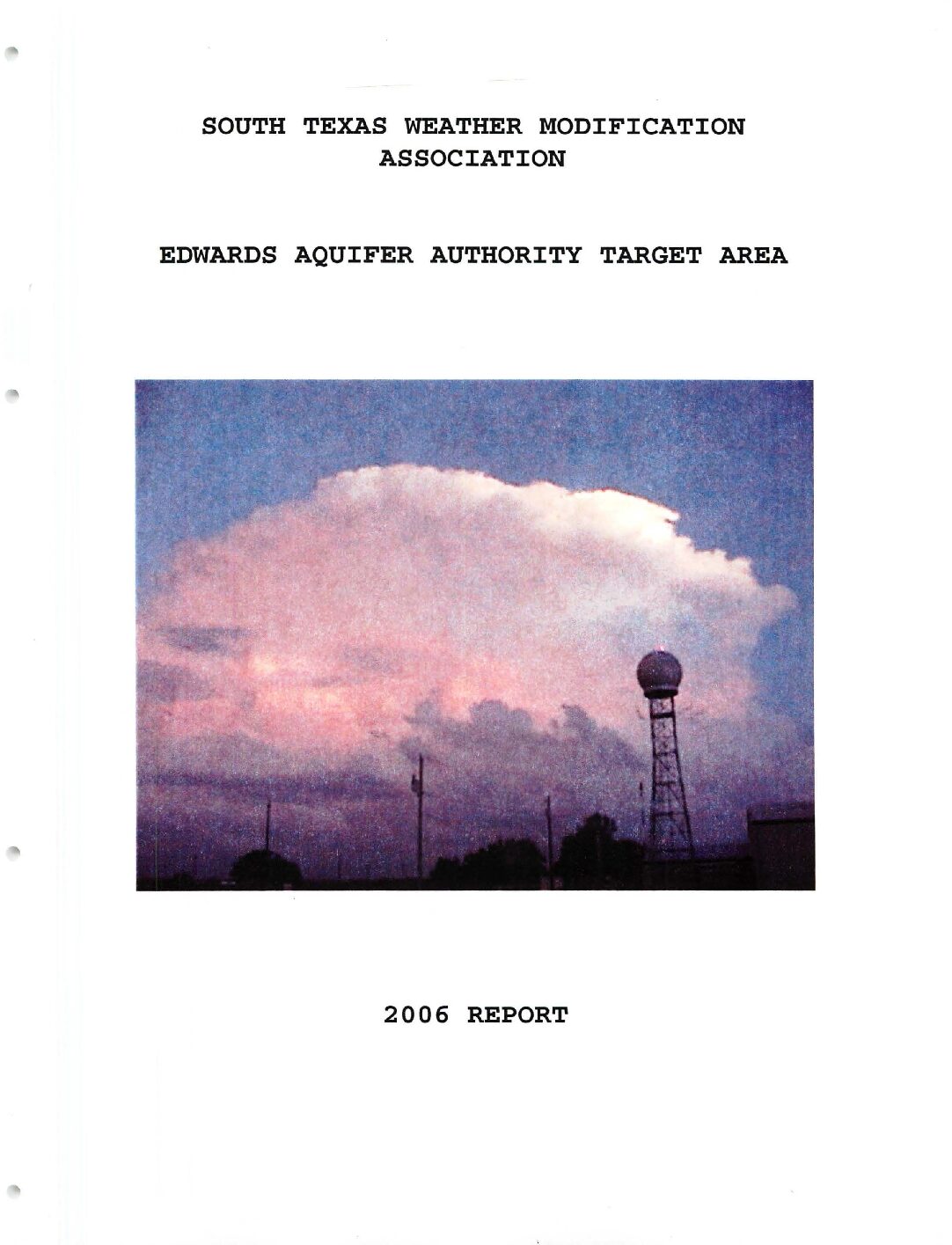
Description: Report of the Edwards Aquifer Authority weather modification program for 2006
Location: South Texas
Summary:2006 marked the fifth year of operations for the Edwards Aquifer Authority (EAA ) by the STWMA . Due to the dry weather experienced during much of the season, there were fewer opportunities for seeding compared to previous years. For the May-October period, there were 14 days on which cloud seeding operations took place within the target area. This compares with 25 days of seeding in 2005, 20 days of seeding in 2004, 22 days in 2003, and 8 days in 2002.
Cloud seeding missions did not take place in May due to convection occurring at night or warnings being issued. June fared a bit better, with two missions taking place during the second half of the month as a tropical airmass affected the area; however , high pressure domainated [sic] the area for a good part of the month, effectively capping the convective potential . The weather pattern became more conductive [sic] to favorable seeding conditions in July, with seeding taking place on six days . High pressure once again exerted its effects on the area during much of August:, although there were four days two near the beginning of the month and two near the end where clouds were seeded within the target area. September was quieter than usual, with only two days on which seeding operations took place. This turned out to be the end of the season, as no seeding took place during October.
Once the season concluded, Archie Ruiz, who works for Active Influence performing radar evaluations for the Texas weather modification projects, completed the radar evaluation of the program. Once again, the analysis shows that seeding may have produced favorable increases in rainfall, with apparent lifetime extensions in the seeded clouds along with other positive results. These numbers are presented and discussed towards the end of the report.
Unlike the past, the flight tracks are not included in the hard copy of the 2006 report; instead, they are on a CD attached to this report.
South Texas Weather Modification Association Edwards Aquifer Authority Target Area 2005 Report


Description: Report of the Edwards Aquifer Authority weather modification program for 2005
Location: South Texas
Summary:2005 marked the fourth year of operations for the Edwards Aquifer Authority (EAA) by the STWMA. Once again, N57AA was stationed at Stinson Field (SSF) in south San Antonio. Two of our pilots, Ron Merks and Mickey Chadwell, were stationed there. They worked along with Jim Transue and Tim Pickens, stationed at Pleasanton, and Larry Dement, stationed at Kenedy. N57AA did not fly as much this season due to flare rack problems, but Jim Transue and N8847P were able to fly numerous seeding missions in the EAA target area, henceforth referred to as the target area.
2005 turned out to be a good year for seeding in the target area, with 25 days of seeding. This compares with 20 days of seeding in 2004, 22 days in 2003, and 8 days in 2002. May saw a few days with seedable clouds, but was quieter than usual. June was incredibly disappointing, with no seeding missions taking place due to high pressure sitting over the area, effectively capping the convective potential. July exhibited a dramatic swing from June, with seeding taking place on 11 days within the target area. The busier weather pattern continued into August, with seeding missions taking place on seven days. Things began to wind down as fall approached, with only three days of seeding in September, and two in October. Despite the increase in convective activity over last year, rainfall amounts were significantly less in 2005, with some areas reporting rainfall deficits by the end of the year in excess of ten inches; this was mainly over Bexar County. Areas a bit further west over Medina and Bandera counties saw rainfall amounts closer to normal, but still on the dry side. A brief discussion on the meteorological perspective of the weather in summer 2005, along with seeding events will be presented later in the report.
Once the season concluded, Archie Ruiz, who works for Active Influence performing radar evaluations for the Texas weather modification projects, completed the radar evaluation of the program. Once again, the analysis shows that seeding may have produced favorable increases in rainfall, with apparent lifetime extensions in the seeded clouds along with other positive results. These numbers are presented and discussed towards the end of the report.
South Texas Weather Modification Association Edwards Aquifer Authority Target Area 2004 Report

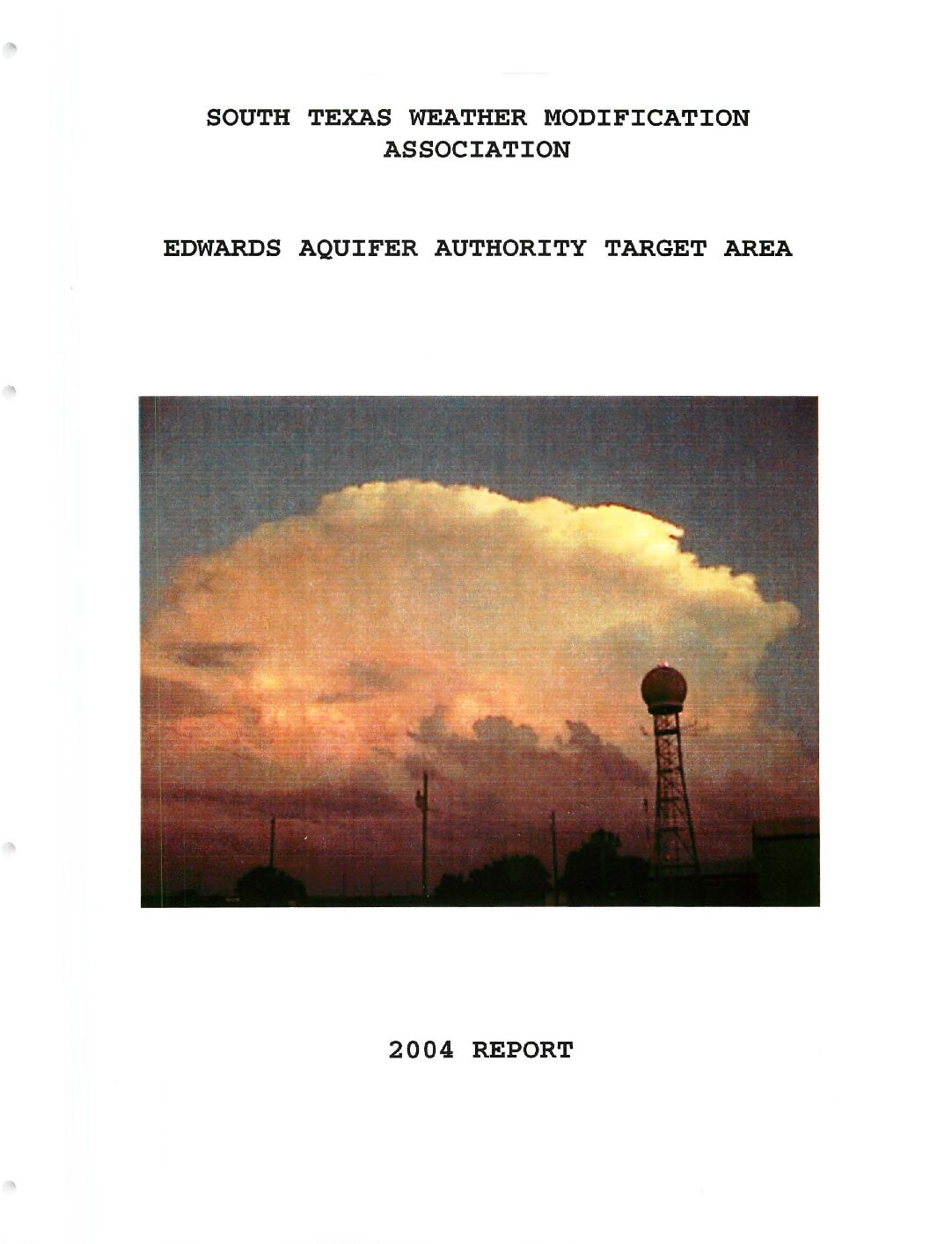
Description: Report of the Edwards Aquifer Authority weather modification program for 2004
Location: South Texas
Summary:2004 marked the third year of operations for the Edwards Aquifer Authority (EAA) by the STWMA. As was the case in 2002 and 2003, one plane, N57AA, was stationed at Stinson Field (SSF) in south San Antonio. Two of our pilots, Ron Merks and Mickey Chadwell, were stationed there. They worked along with Jim Transue and Tim Pickens, stationed at Pleasanton, and Larry Dement, stationed at Kenedy. Occasionally the other pilots helped out with seeding in the EAA target area, henceforth referred to as the target area.
2004 turned out to be a good year for seeding in the target area, with 20 days of seeding. This compares with 22 days of seeding in 2003, and only 8 in 2002. May turned out to have a few convective events, none of which were seeded due either to storms occurring at night or the location of the storms over the city of San Antonio. The first seeding mission of the year took place on June 7th, when a surge of tropical moisture brought waves of showers and thunderstorms northward across the area. June ended up being a very wet month, so wet in fact, that a temporary suspension was put in place for the last few days of June due to excessive rainfall and numerous Flash Flood Warnings being issued. The remainder of the year saw some good activity with October 27th being the final day of seeding within the target area. A brief discussion on the meteorological perspective of the seeding events will be presented later in the report.
Once the season concluded, Archie Ruiz, who works for Active Influence performing radar evaluations for the Texas weather modification projects, completed the radar evaluation of the program. Once again, it appears that seeding produced favorable increases in rainfall, with apparent lifetime extensions in the seeded clouds along with other positive results. These numbers are presented and discussed towards the end of the report.
As was mentioned in the 2003 annual report, the weather modification projects in Texas now have a contract with Weather Decision Technologies, Inc., based out of Norman, Oklahoma. The company provides the projects with live NEXRAD feeds from the various National Weather Service offices nearest to their respective target areas. For the target area, a feed from the WSR-88D radar at New Braunfels (KEWX) is used. The WSR-74C radar at the Pleasanton Municipal Airport is still used in conjunction with the NEXRAD data, and this secondary radar data may be analyzed in the near future to determine any possible differences.
Southwest Texas Rain Enhancement Association 2009 Edwards Aquifer Authority Final Report

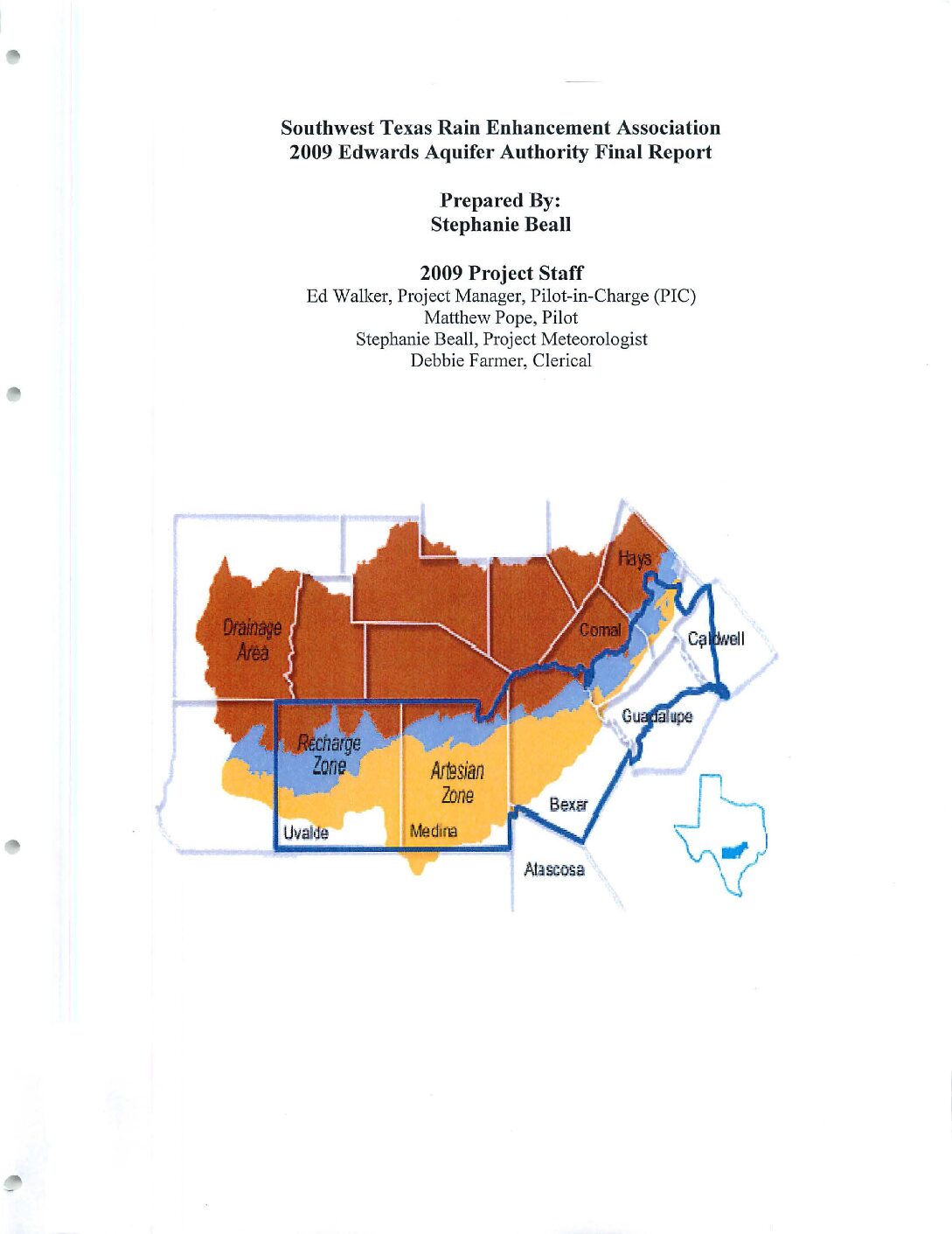
Description: Weather modification program by Southwest Texas Rain Enhancement Association for the Edwards Aquifer Authority in 2009
Location: San Antonio Region
Summary:2009 marked the eighth year of operations for the Edwards Aquifer Authority (EAA) by the Southwest Texas Rain Enhancement Association (SWTREA). The project duration was the same as it has been the past couple of years, with seeding taking place in Uvalde County from May until September. Drought conditions that originated in late 2008 continued into most of 2009, which in tum had an effect on seeding operations for most of the summer.. Seeding in the Authority target area of Uvalde County saw a total of twenty-four seeding flights for the 2009 operational season.
As was the case last year, in addition to normal weather modification activities in the Edwards Aquifer Authority (EAA) target area, 2009 was the third year for a randomized seeding experiment. The randomized seeding experiment was also conducted by the EAA's other weather modification contractor, the South Texas Weather Modification Association (STWMA). Due to bias that could occur the experin1ent was double blind so that ground operations staff would not know which clouds were seeded and which were not seeded.
No randomized seeding flights took place in Uvalde County during the 2009 season. The reason for no flights during the season was due to the fact that most ofthe convection in the EAA target area did not meet the randomized criteria.
At the September 30th conclusion of the 2008 operational season for the EAA target area, a radar evaluation was completed for the program. The findings are presented and discussed towards the end of this report. The flight logs for the 2009 seeding season are [shown].
South Texas Weather Modification Association EAA Target Area 2003 Report


Description: Report of the Edwards Aquifer Authority weather modification program for 2003
Location: South Texas
Summary:2003 marked the second year of operations for the EAA by the STWMA. One change seen was the extension of the seeding season from September 30th to October 31st. This was done in 2002 as a result of the downtime we experienced due to flooding rains. For 2003, the extension really didn't make much of a difference, as no seeding was done after September 17th.
As was the case in 2002, one plane, N57AA, was stationed at Stinson Field (SSF) in south San Antonio. Two of our pilots, Ron Merks and Mickey Chadwell, were stationed there. They worked along with Jim Transue and Tim Pickens, stationed at Pleasanton, and Larry Dement, stationed at Kenedy. Occasionally the other pilots helped out with seeding in the EAA target area.
2003 turned out to be a much better year for seeding in the EAA target area, with 22 days of seeding, compared with only 8 in 2002. With a record-setting dry spell in May, our first seeding mission did not take place until May 27th. June saw 4 days with seeding, while July ended up being the busiest month, with 8 seeding days. Hurricane Claudette tracked across south Texas on July 15th, bringing heavy rain and high winds to much of the area. Due to a risk of flooding, operations were suspended from the 15th through the 20th to allow for any rains to soak in and flooded rivers to recede. A rare July cold front pushed down into Texas on July 23rd. The front itself stayed north of the area, but a pre-frontal trough did make it through the area, igniting showers and thunderstorms. The busy weather continued into August, with 7 days of seeding taking place. Things quieted down in September, with only two days of seeding. After the middle of the month, there were no more missions for the year.
Once the season concluded, Archie Ruiz completed the radar evaluation of the program, and again it appears that seeding produced favorable increases in rainfall. These numbers are presented and discussed on page 36 of this report.
For 2004, there will be a dramatic change in the radar data. We have acquired an agreement with WDT, a company based in Oklahoma City. They will be taking the TITAN software, which we currently use in conjunction with our C-band radar, and integrating it into the National Weather Service Doppler radars in New Braunfels, Corpus Christi, and Brackettville. Starting in 2004, our program will use WDT's software to peruse radar data from the NWS in order to conduct operations. It is an exciting change, since the meteorologist will now have access to many of the algorithms currently used by the NWS. Some of these include, but are not limited to, tornado detection, hail detection, lightning strike display, and future radar, which takes past reflectivities and extrapolates 30-60 minutes into the future to give you a predicted radar image. Radial velocity data will also be available, which lets the meteorologist look at the winds within a storm.
2003 saw more activity weatherwise compared to the previous year, and as such, we saw more cloud seeding missions take place in the EAA target area. Radar analysis showed that seeding effects this year were positive once again.
Overall, the main factor that is evident from comparing the 2002 and 2003 analyses deals with the cloud attributes. The clouds in 2002 were larger, on average, and appeared to contain more water than those in 2003. When looking at the parameter increases alone, 2003 was a more successful year in terms of the apparent effectiveness of seeding.
With further work in weather modification in the EAA target area and more analyses, we will get a better understanding of the effects of glaciogenic seeding in south Texas.
 Conditions
Conditions

 CURRENT
CURRENT 
